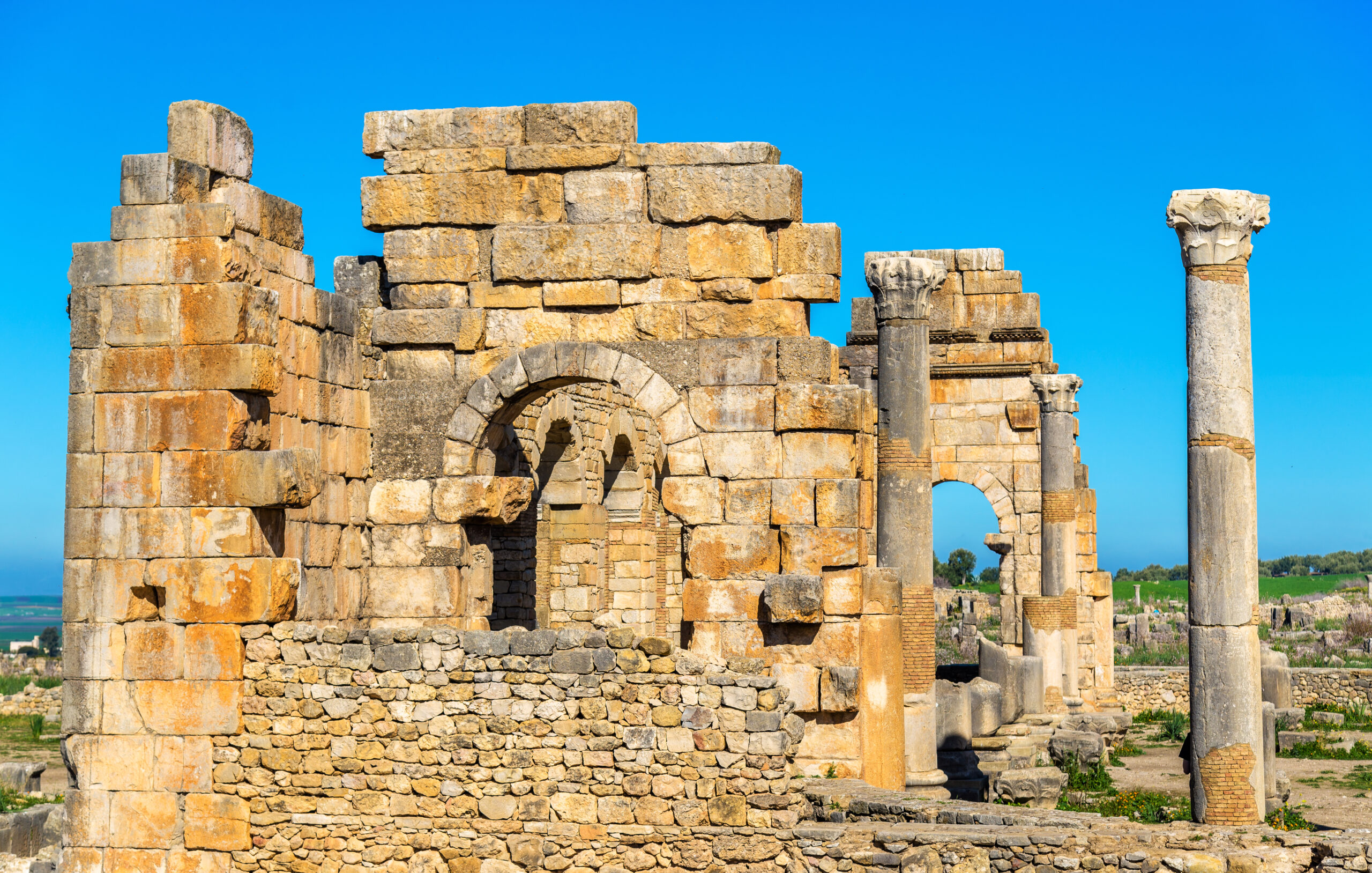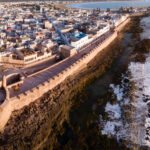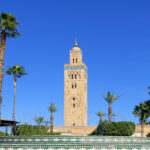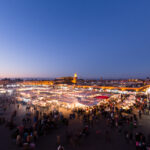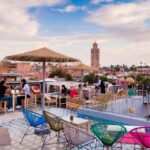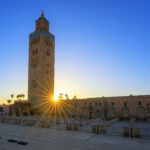Discovering the Historical Monuments and Architecture of Morocco
Morocco, a country steeped in history and culture, ranks among the top tourist destinations in North Africa. With its rich blend of traditions, stunning landscapes, and architectural wonders, Morocco attracts visitors from all over the world. The World Tourism Organization recognized it as the leading tourist destination in the Arab region in 2017. This recognition stems not only from its beautiful weather but also from the numerous ancient sites that reflect its deep-rooted history.
In this article, we’ll explore the historical monuments and architecture that make Morocco a fascinating destination, from the bustling streets of Marrakech to the historic city of Fes.
The Architectural Marvels of Marrakech
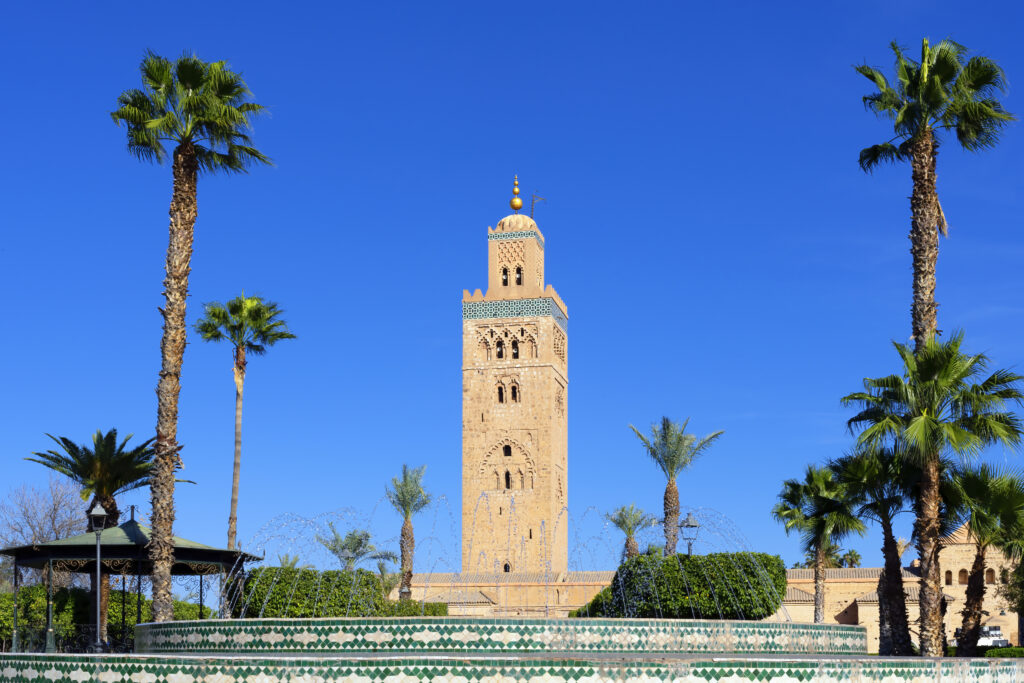
Often called the “Red City” due to the distinctive red walls that surround it, Marrakech boasts a rich history and culture. Founded in 1062, Marrakech once served as the imperial capital of a vast empire that extended well into Europe. The city blends different cultures, shaped by the various dynasties that ruled it over the centuries.
The Bahia Palace
One of most famous historical monuments in Morocco, the Bahia Palace, stands in the heart of Marrakech. Minister Ahmed bin Musa built it during the Alawite dynasty in the late 19th century. The Bahia Palace, meaning “brilliance,” lives up to its name with its intricate designs and beautiful gardens.
Construction of the Bahia Palace took six years, with the best craftsmen and artisans of the time contributing to its creation. Although Minister Ahmed bin Musa passed away before completing the palace, it still stands as a testament to grandeur. Visitors can marvel at its beautiful courtyards, intricate tilework, and stunning wooden ceilings.
The Koutoubia Mosque
Another historical monument in Marrakech, the Koutoubia Mosque, was built in 1150. It stands as an outstanding example of Islamic architecture. The mosque’s towering minaret, reaching 65 meters, is visible from all parts of the city and has become a symbol of Marrakech.
The name “Koutoubia” comes from the Arabic word “kutubiyyin,” which means “booksellers.” The mosque serves not only as a place of worship but also as a significant historical monument. Its design, with 17 naves and 11 domes, showcases the architectural prowess of the Almohad dynasty. The Koutoubia Mosque’s minaret, adorned with intricate carvings and a turquoise ceramic frieze, ranks among the most beautiful in the Islamic world.
Jemaa El Fna Square
No visit to Marrakech is complete without experiencing the vibrant atmosphere of Jemaa El Fna Square. Located next to the Koutoubia Mosque, this historic square serves as the heart of the city. Every day, storytellers, musicians, snake charmers, and food stalls bring the square to life, offering a glimpse into Morocco’s rich cultural heritage.
UNESCO recognized Jemaa El Fna as an intangible cultural heritage of humanity, underscoring its importance in preserving Moroccan traditions. Whether you’re watching a performance, sampling local street food, or simply soaking in the lively atmosphere, Jemaa El Fna brings history and culture to life.
Menara Gardens
The Menara Gardens offer a serene escape. Located about a 45-minute walk from Jemaa El Fna, these gardens are filled with olive trees and centered around a large reflecting pool. The gardens date back to the 12th century, originally designed as a place of relaxation for the sultans.
The Menara Pavilion, overlooking the pool, stands as a beautiful example of Islamic architecture. The calm waters of the pool reflect the snow-capped peaks of the Atlas Mountains in the distance, creating a picturesque setting. The gardens provide a perfect spot for a leisurely stroll and a chance to enjoy the natural beauty of Marrakech.
Saadian Tombs
The Saadian Tombs offer another must-see site in Marrakech. Dating back to the late 16th century, these tombs served as the final resting place of Sultan Ahmad al-Mansur and his family. Hidden for centuries, they were only rediscovered in 1917, making them one of the city’s most significant historical sites.
Renowned for their exquisite decoration, the tombs feature intricate tilework, carved cedarwood, and beautiful stucco. The site offers a fascinating glimpse into the opulence of the Saadian dynasty and their contribution to Moroccan architecture.
Madrasa Ben Youssef
Madrasa Ben Youssef is one of the most impressive examples of Moorish architecture in Morocco. Founded in the 14th century and rebuilt by the Saadian dynasty in the 16th century, this former Islamic college is a masterpiece of Moroccan design, with its ornate courtyards, detailed tilework, and intricately carved wooden ceilings.
The madrasa was once the largest in North Africa, accommodating up to 900 students. Today, it stands as a symbol of Morocco’s rich educational and architectural heritage. Visitors can explore the madrasa’s beautiful courtyards and admire the stunning craftsmanship that went into its construction.
Historical Monuments in Morocco Casablanca: A Blend of Tradition and Modernity
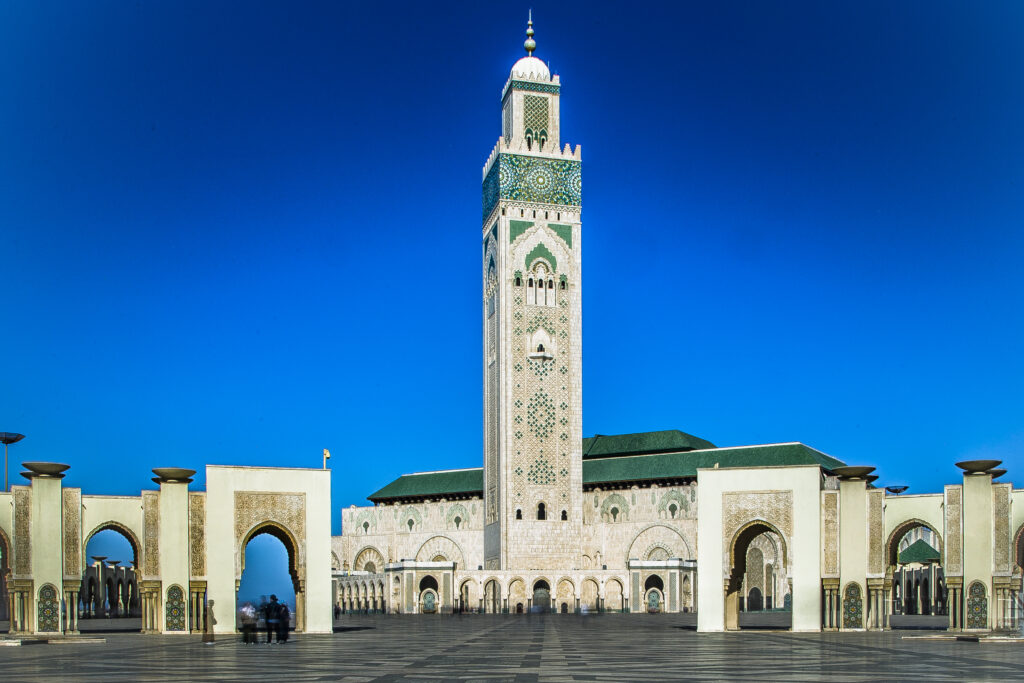
Casablanca, the largest city in Morocco, is a modern metropolis with a rich history. Located on the Atlantic coast, Casablanca serves as the country’s economic heart and a common starting point for visitors. The city houses some of Morocco’s most significant historical monuments.
Hassan II Mosque
The Hassan II Mosque, Casablanca’s most iconic landmark, ranks among the world’s most impressive mosques. Completed in 1993, the mosque was built to commemorate the late King Hassan II. Its minaret, standing at 210 meters, holds the title of the tallest in the world, and the mosque itself is the largest in Africa.
As a masterpiece of modern Moroccan architecture, the mosque combines traditional design elements with cutting-edge technology. The prayer hall accommodates 25,000 worshippers, with space for an additional 80,000 in the courtyard. The mosque, built partially over the Atlantic Ocean, features a retractable roof, allowing worshippers to pray under the open sky.
The intricate tilework, carved plaster, and beautiful woodwork that adorn the mosque showcase the skill of Moroccan artisans. The Hassan II Mosque serves not just as a place of worship but also as a symbol of Morocco’s architectural and cultural heritage.
The Medina of Casablanca
While Casablanca’s medina may not be as ancient as those in other Moroccan cities, it still offers a worthwhile exploration. Located near the train station and the Hassan II Mosque, the medina presents a maze of narrow streets filled with shops, cafes, and historic buildings. It’s a great place to experience local culture and pick up souvenirs.
The medina also houses some beautiful examples of Moorish architecture, with its arched doorways, intricate tilework, and traditional Moroccan houses. A stroll through the medina provides a glimpse into the city’s past and a chance to experience its vibrant atmosphere.
Casa Art Deco
Casablanca also stands out for its unique blend of architectural styles, particularly its Art Deco buildings. Under French colonial rule in the 1930s, the city transformed into a modern metropolis with wide boulevards and grand buildings. The Art Deco style, characterized by its geometric shapes and bold designs, can be seen throughout the city center.
The central business district, in particular, offers one of the best places to admire Casablanca’s Art Deco architecture, with beautifully preserved buildings reflecting the city’s colonial past. The blend of Moroccan and European architectural styles creates a unique and captivating urban landscape.
Fes: The Spiritual and Cultural Capital of Morocco
Fes, the oldest of Morocco’s imperial cities, is a city steeped in history and tradition. Often referred to as the spiritual and cultural capital of Morocco, Fes is home to some of the country’s most important historical sites and architectural treasures.
Al-Qarawiyyin University and Mosque
Al-Qarawiyyin University in Fes, founded in 859 by Fatima al-Fihri, stands as the oldest continuously operating university in the world. The university has served as a center of learning for over a thousand years. Its mosque, Al-Qarawiyyin Mosque, ranks among the largest in Africa and serves as a significant religious site in Morocco.
The mosque is an architectural marvel, with its vast prayer hall, intricate tilework, and beautiful minaret. Over the centuries, it has been expanded and renovated by various dynasties, each leaving its mark on the structure. The mosque and university are a symbol of Morocco’s long-standing tradition of education and intellectual pursuit.
The Batha Museum
The Batha Museum, located in a former royal palace, is one of the most important museums in Fes. The palace was built in the late 19th century and converted into a museum in 1915. The museum houses a collection of traditional Moroccan arts and crafts, including ceramics, woodwork, and textiles.
The museum’s architecture is a blend of Andalusian and Moroccan styles, with its beautiful courtyards, fountains, and intricate tilework. A visit to the Batha Museum offers a chance to learn about Morocco’s rich cultural heritage and admire the craftsmanship of its artisans.
Madrasa Bou Inania
Madrasa Bou Inania is another architectural gem in Fes. Built between 1350 and 1355, this madrasa served as both a school and a mosque. The madrasa is one of the few religious sites in Morocco that is open to
non-Muslim visitors, making it a must-see for anyone interested in Moroccan architecture.
The madrasa’s design is a masterpiece of Islamic art, with its intricate stucco, carved wood, and colorful zellij (tilework). The central courtyard, with its beautiful fountain and stunning decoration, is a highlight of the site. Madrasa Bou Inania is a testament to the artistic and architectural achievements of the Marinid dynasty.
The Medina of Fes
The medina of Fes, known as Fes el-Bali, is one of the largest and best-preserved medieval cities in the world. Declared a UNESCO World Heritage site in 1981, the medina is a labyrinth of narrow streets, bustling markets, and historic buildings.
The medina is home to countless treasures, including ancient mosques, madrasas, and palaces. The intricate tilework, carved plaster, and beautiful woodwork that adorn these buildings are a testament to the skill of Moroccan artisans. A walk through the medina is like stepping back in time, offering a glimpse into the rich history and culture of Morocco.
Chouara Tannery
One of the most iconic sites in the medina of Fes is the Chouara Tannery. This tannery is one of the oldest in the world and has been in operation for over a thousand years. The sight of the tannery’s colorful dyeing vats, filled with natural dyes made from plants and minerals, is one of the most memorable in Morocco.
Visitors can watch the traditional process of leather-making from the terraces overlooking the tannery. The strong smell of the tanning process is a reminder of the hard work and craftsmanship that goes into producing Morocco’s famous leather goods.
Meknes: The Imperial City of Sultan Moulay Ismail

Meknes, one of Morocco’s four imperial cities, was the capital of the country under Sultan Moulay Ismail in the 17th century. Known as the “Versailles of Morocco,” Meknes is a city of grand palaces, impressive gates, and beautiful gardens.
Bab Mansour
Bab Mansour, the main gate to the medina of Meknes, is one of the most remarkable historical monuments in Morocco. Completed in 1732, the gate is a masterpiece of Moroccan architecture, with its intricate tilework, carved stone, and beautiful zellij.
Bab Mansour was built by Sultan Moulay Ismail and named after its architect, El-Mansour. The gate is a symbol of the sultan’s power and his vision for Meknes as a grand imperial city.
The Mausoleum of Moulay Ismail
The Mausoleum of Moulay Ismail is another important site in Meknes. The mausoleum is the final resting place of Sultan Moulay Ismail, one of Morocco’s most powerful and influential rulers. The sultan is known for his ambitious building projects, which included the construction of the massive city walls and the grand palace complex in Meknes.
The mausoleum is a beautiful example of Moroccan architecture, with its intricate tilework, carved stucco, and stunning courtyards. It is also one of the few religious sites in Morocco that is open to non-Muslim visitors, making it a popular destination for tourists.
Rabat: The Modern Capital with Ancient Roots
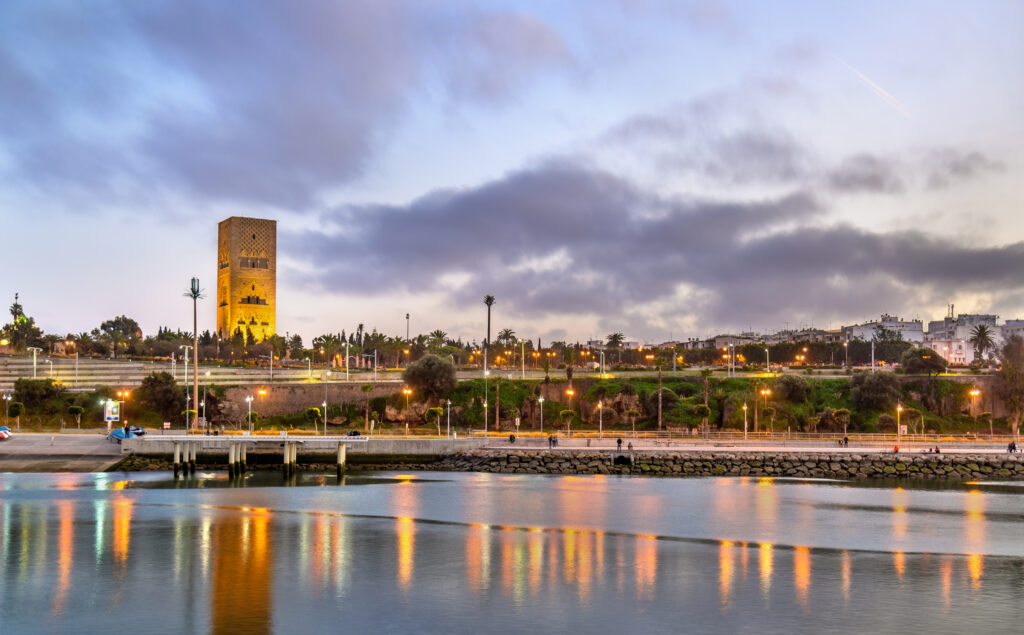
Rabat, the capital city of Morocco, is a city that blends the old and the new. While it is the political and administrative center of the country, Rabat is also home to several important historical monuments in Morocco, that highlight the country’s diverse heritage.
Hassan Tower
One of the most iconic landmarks in Rabat is the Hassan Tower. This unfinished minaret was originally intended to be the tallest in the world, but construction was halted after the death of Sultan Yacoub al-Mansour in 1199. Despite its incomplete state, the tower is an impressive sight, standing at 44 meters tall.
The Hassan Tower is part of a larger complex that includes the ruins of a mosque and the Mausoleum of Mohammed V. The site is a symbol of Morocco’s rich architectural heritage and its connection to the Almohad dynasty.
The Kasbah of the Udayas
The Kasbah of the Udayas is another must-see site in Rabat. This historic fortress, located at the mouth of the Bou Regreg River, dates back to the 12th century. The kasbah is a maze of narrow streets, whitewashed houses, and beautiful gardens, offering stunning views of the Atlantic Ocean.
The Kasbah of the Udayas is also home to the Andalusian Gardens, a peaceful oasis filled with exotic plants and flowers. The kasbah’s history, architecture, and beautiful surroundings make it a popular destination for visitors to Rabat.
Chellah
Chellah is an ancient Roman city located on the outskirts of Rabat. Founded in the 3rd century BC, Chellah was later abandoned and repurposed as a necropolis by the Marinid dynasty in the 14th century. Today, the site is a fascinating mix of Roman and Islamic ruins, with its crumbling walls, ancient tombs, and beautiful gardens.
Visitors to Chellah can explore the ruins of the Roman city, including the remains of a forum, baths, and a triumphal arch. The site is also home to the tombs of several Marinid sultans, making it an important historical and cultural landmark in Morocco.
Conclusion: Discovering the Historical Monuments in Morocco
Morocco’s historical monuments and architecture are a testament to its rich and diverse cultural heritage. From the grandeur of Marrakech’s palaces to the ancient medina of Fes, each city offers a unique glimpse into the country’s history. Whether you’re exploring the vibrant streets of Marrakech, the spiritual sites of Fes, or the modern capital of Rabat, you’ll be captivated by the beauty and history that Morocco has to offer. So, pack your bags and embark on a journey through time, discovering the architectural wonders that make Morocco a truly remarkable destination.

